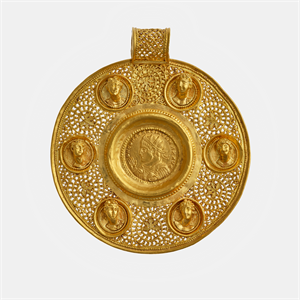Bibliography
H. Cohen, R. Gaidoschik, G. Probszt-Ohstorff, and G. L. Feuardent, Description historique des monnaies frappées sous l'Empire romain communément appelées médailles impériales, 2 ed. (Paris & Leipzig, 1880-1892), 320-321, no. 1-2.
J. M. C. Toynbee, Roman Medallions, Numismatic Studies 5 (New York, 1944), 197, no. 7, pl. 31.
Catalogue of ancient jewellery, Classical, Celtic, Egyptian and Western Asiatic Antiquities and an Important Group of Early Byzantine Gold Medallions, Coins and Jewellery, from Various Sources: which will be sold at auction by Christie, Manson & Woods... Monday, October 19, 1970 (London, 1970), no. 200.
K. Weitzmann, Age of Spirituality: Late Antique and Early Christian Art, Third to Seventh Century, ed. K. Weitzmann, exhibition catalogue, Metropolitan Museum of Art, November 19, 1977-February 12, 1978, (New York, 1979), 304, no. 276.
C. Metzger, "Les biloux monétaires dans l'Antiquité tardive," Les Dossiers de l'archéologie 40 (1980): 82-90, fig. 12.
C. Mango, "The Byzantine Collection," Apollo 119 (1984): 21-29, fig. 8.
N. Dürr and P. Bastien, "Trésor de solidi (353-388)," Revue Suisse de Numismatique = Schwizerische numismatische Rundschau 63 (1984): 205-40.
L. Pirzio Biroli Stefanelli and B. Pettinau, L'oro dei Romani: gioielli di età imperiale, Metallo: mito e fortuna nel mondo antico (Rome, 1991), 272, no. 257, fig. 281.
J.-A. Bruhn, Coins and Costume in Late Antiquity, Dumbarton Oaks Byzantine Collection Publications 9 (Washington, D.C., 1993), 16, 22, no. 4.
P. Grierson, "Six Late Roman Medallions in the Dumbarton Oaks Collection," Dumbarton Oaks Papers 50 (1996): 139-45, fig. 2.
B. Deppert-Lippitz, "Late Roman Splendor: Jewelry from the Age of Constantine," Cleveland Studies in the History of Art 1 (1996): 30-71, esp. 50-53, 56-58, fig. 14a-b, 15a-b, 171-f.
D. Buckton, Byzantium: Treasures of Byzantine Art and Culture from British Collections, exhibition catalogue, British Museum, (London, 1994), 26-27.
A. Geroulanou, Diatrita: Gold Pierced-work Jewellery from the 3rd to the 7th Century (Athens, 1999), 4, 84, 87, no. 116, fig. 140.
A. L. McClanan, Representations of Early Byzantine Empresses: Image and Empire, The New Middle Ages (New York, 2002), 18, fig. 1.1.
M. C. Ross, S. A. Boyd, and S. R. Zwirn, Jewelry, Enamels, and Art of the Migration Period, Catalogue of the Byzantine and Early Mediaeval Antiquities in the Dumbarton Oaks Collection 2, 2nd ed. (Washington, D.C., 2005), 144-154, no. 180, pl. 100-103, colorpl. I.
Konstantin der Grosse: Imperator Caesar Flavius Constantinus, ed. A. Demandt and J. Engemann, exhibition catalogue, Rheinisches Landesmuseum Trier, Bischöfliches Dom- und Diözesanmuseum Trier, Städtisches Museum Trier, June 2-November 4 2007, (Trier, Mainz am Rhein, 2007), no. I.11.7, pl. p. 366.
R. Cormack, M. Vasilaki, and B. Mouseio, Byzantium, 330-1453, exhibition catalogue, Royal Academy of Arts, London, October 25, 2008 - March 22, 2009, (London: New York, 2008), 411.
G. Bühl, ed., Dumbarton Oaks: The Collections (Washington, D.C., 2008), 48.
A. D. Lazaridou, A. Cameron, H. Saradi-Mendelovici, H. Maguire, and S. Curcic, Transition to Christianity: Art of Late Antiquity, 3rd-7th Century AD, exhibition catalogue, Mouseio Vyzantino, Athens, December 7th, 2011- May 14th 2012, (New York and Athens, 2011), 87, no. 15.
















